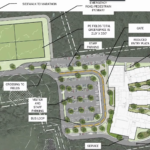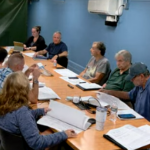The Conservation Commission at its meeting on Tuesday voiced support for Grasshopper Energy to start clearing a limited number of trees as part of its plan to construct a 2.4 megawatt solar array off Wilson Street, but held off on approving larger pieces to the project until more information has been obtained.
The commission reviewed two requests from Grasshopper regarding site clearing on a non-jurisdictional area and a field change request.
“I think that the issue most pressing to us is the ability to move forward with the site clearing,” explained Chris King from Atlantic Design, on behalf of the applicant. “We apologize again for the miscommunication at the last hearing.”
At the previous hearing there was an issue concerning which trees were to be cleared. Since that time, the trees that are to be removed have been flagged. That was confirmed by town consultant Matt Varrell of Lucas Environmental. Varrell said he visited the site Monday morning to review it with company representatives.
Nick Facendola from Level Design Group, working for the applicant, said one request is to do some minor tree clearing at the center of the site, along an existing cart path, to allow vehicles to turn to the easterly portion of the site through the wetland area.
To the west, there are 16 trees that need to be removed, most of which are 3 inches in diameter and in clusters. These need to be cleared to get across a gas easement area, Facendola explained.
Heading south toward Cedar Street (Route 85), the contractor discussed building a small temporary driveway and using the cart path rather than clearing the 15 trees that originally were slated to be removed to build a permanent driveway.
“There’s a little extra cost associated with that to build the temporary driveway that’s outside the 100-foot buffer zone,” Facendola said. However, it would preserve the trees within the buffer zone.
Varrell said erosion control materials would need to be added, noting this is the last area of the project to which erosion controls need to be placed.
King said the applicant is awaiting approval from the Planning Board to modify both the special permit and the stormwater permit.
The only comment added to the proposal was that the seed mix under the solar panels — which are to be packed more tightly together than usual — would need to be changed to grow plants “that are drought tolerant and shade tolerant.” BETA had questioned whether it would be possible for plant growth due to the density of the panels.
“This is a new issue as a permitting engineer, for me at least, dealing with a new question,” King said. “I’m certainly not a seed expert, so I rely on technical expertise that’s available to us as part of our project team and other resources.”
King added that a contingency plan would be in place in case the seeding does not work.
Another issue addressed the concern over the potential impacts to the stormwater system. King said the areas are almost entirely outside of the 100-foot buffer zone. Because BETA, the town’s engineering consultant, is in the process of completing the review and the information is due next week, he asked that the field change request go forward.
“I understand your point,” Barnes said. “I think it seems to me that you’ve met the requirements for the project change request. It is outside our jurisdiction, but we share responsibility for stormwater issues with the Planning Board. So we need to make sure those are addressed properly.”
He added that he would be more comfortable getting “the blessing from BETA that they are in agreement with the changes.” Commission co-vice chair Melissa Recos agreed.
Ahmed Hafez from Grasshopper said the information “has been vetted by BETA already and responded to,” and the change regarding the seeding has been confirmed.
“I would just disagree that stormwater is within our purview because it does go to the wetlands. My primary concern would be the erosion issues, ground cover issues related to stormwater,” Recos stated.
Don MacAdam, the town’s conservation administrator, told the committee, “Situations that occur outside the jurisdiction that may have negative impacts on your jurisdiction, that comes under your purview.”
King opined that it is “more in a reactionary sense, if you will.”
“If you were to use that broad brush interpretation for all new projects, you’re telling me that any project that has stormwater associated with it – whether it’s within 100 feet or not of a wetland — is within the commission’s jurisdiction, I just think it’s a huge precedent to set,” he added.
Interjected Barnes: “We prefer not to be reactionary and be proactive in these types of situations.”
He explained that there were several town projects in the past where runoff and sediment occurred after the committee gave the developer “the benefit of the doubt.”
“It turns out to be a major headache for the commission,” Barnes said. “It turns out to be a major headache for abutters. It turns out to be a major headache for the applicant, because you end up having to do mitigation and there are fines associated with it.”
Barnes said that while the applicant can start the tree clearing as previously discussed, to gain access to the upland areas, the second piece will need to be put off until after BETA’s review. It will be discussed at the committee’s next meeting on March 23.






















0 Comments